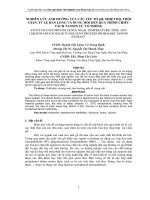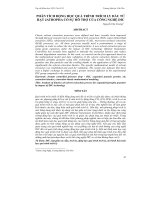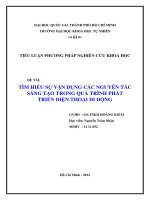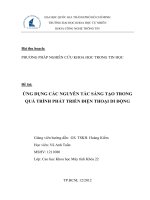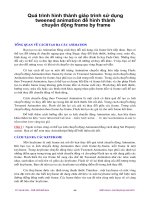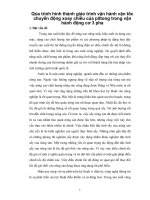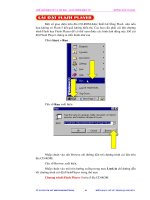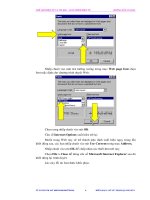Quá trình hình thành giáo trình chuyên ngành điện tử viễn thông - mạng điện thoại tiếng anh chuyên ngành p10 ppt
Bạn đang xem bản rút gọn của tài liệu. Xem và tải ngay bản đầy đủ của tài liệu tại đây (234.06 KB, 8 trang )
Unit 6. Digital Telephone Exchanges
71
UNIT 6. DIGITAL TELEPHONE EXCHANGES
I. GIỚI THIỆU
Bài 6 giới thiệu các đặc điểm của tổng đài số, nguyên tắc chuyển mạch phân chia theo không gian
và thời gian
1. Mục đích yêu cầu
Sau khi nghiên cứu bài 6, sinh viên cần:
1. Nắm được các đặc điểm của tổng đài điện tử (tổng đài số).
2. Nắm được các ưu điểm tổng đài điện tử so với tổng đ
ài thế hệ cũ.
3. So sánh nguyên tắc chuyển mạch phân chia theo không gian và thời gian.
4. Thành lập câu hỏi thông tin và câu cung cấp thông tin.
2. Tóm tắt nội dung
1. Tổng đài số có ưu điểm hơn hẳn so với tổng đài tương tự.
2. Các đặc tính của tổng đài số: Điều khiển theo chương trình đã cài đặt sẵn, báo hiệu kênh
chung, công nghệ vi điện tử, truyề
n dẫn và chuyển mạch số tích hợp.
3. Ma trận chuyển mạch, công nghệ chuyển mạch phân chia theo không gian và thời gian.
4. Nguyên tắc vận hành PABX.
5. Câu hỏi thông tin có thể dùng những hình thức câu lịch hỏi mang tính gián tiếp, sử dụng
Could you tell me…/ Would you mind explaining…/ Perhaps you would let me know…
6. Câu chỉ dẫn có thể sử dụng thức mệnh lệnh hay sử dụng câu thường. Trợ động từ “Do”
được sử dụng khi nhấn mạnh.
II. NỘI DUNG
1. READING 1
Read the following text carefully.
Much of the world's telephone traffic is still handled by exchanges of electromechanical
design, each with thousands of wear-prone exposed moving parts. Analogue exchanges of this
type are costly to install and maintain, and are subject to familiar faults such as crossed lines,
noise and wrong numbers.
Many of the world's telecommunications administrations have explored other, digital,
solutions. They are designing networks that offer: a much higher quality of service than before,
using the latest microchip technology with few or no moving parts; less interference than
previously; lower installation and maintenance costs; and much faster connection speed for calls
and fewer wrong numbers than in the past.
The main characteristics of a digital exchange are:
1. Integrated Digital Transmission and Switching
Unit 6. Digital Telephone Exchanges
72
Speech and other signals are digitally encoded and a common method of time division
multiplexing is used in both transmission and switching equipment. The main advantage of this
system is that the transmission loss encountered by speech becomes more or less independent of
both distance and the number of exchanges through which a call is routed.
2. Stored Program Control (SPC) is the application of data processing and computer
techniques to an exchange, thus providing a powerful, flexible method of controlling the operation
of the exchange.
3. Common Channel Signalling (CCS) uses just one (go and return) pair of signalling
channels, not directly associated with the traffic circuits, for performing all the signalling
functions of an entire route which may contain several hundred traffic circuits.
4. Microelectronics technology is the application of solid-state semiconductor
technology to provide components which range in function from a single active element (e.g. a
transistor) to large scale integrated circuits. Use of this technology offers small physical size and
reliability, together with automated design, manufacture and testing. The components are fixed
onto printed circuit boards, and if there is a fault, the defective printed circuit board can be taken
out and replaced by another in matter of seconds.
1.1. Main phrases
- be subject to: phạm, chịu, gặp phải
- more or less: phần nào
- in a matter of seconds: chỉ sau/ trong vòng vài giây
- digitally encoded: mã hoá thành số
- range in function: có nhiều chức năng khác nhau
- single active element: phần tử kích hoạt đơn
1.2. Decide whether the statements are about Disadvantages of Electromechanical exchanges
(DE) or Advantages of Digital exchanges (AD).
Example: 1. High cost of installation and maintenance. DE
DE
1. High cost of installation and maintenance
2. Interference
Unit 6. Digital Telephone Exchanges
73
3. Virtually no transmission loss
4. Crossed lines
5. Wrong numbers
6. Data-processing techniques used
7. Lower installation and maintenance costs
8. Easy replacement of printed circuit boards
9. Much faster connection speeds
10. Replacement of wear-prone exposed moving parts (maintenance)
11. Greater reliability
12. Fewer wrong numbers
13. Greater network flexibility
1.3. Give each set of functions one main characteristic of digital exchanges.
Functions of digital exchanges Main characteristic
1. The application of solid-state semi-conductors to provide
greater reliability, smaller size and automated design.
2. The application of data-programming techniques to an
exchange, providing greater control and flexibility in
the operative of an exchange.
3. The use of one pair of channels not directly associated
with the traffic circuits, to perform all signalling
functions on a complete route.
4. Speech and other signals are digitally encoded and a
common method of time-division multiplexing is used.
e.g. Microelectronics
Technology
…
…
…
1.4. Match the following terms with a suitable explanation.
Example: 1. an electromechanical exchange
f. a switching centre, the design of which is based on thousands of moving
parts
1. an electromechanical exchange
2. a digital exchange
3. a wrong number
4. a crossed line
5. analogue transmission
6. call charges
a. a call is incorrectly routed
b. a system in which a varying electrical current
transmits the caller's voice pattern
c. an exchange which uses microchip technology
d. the cost of a telephone call
e. during a telephone conversation, you hear another
conversation at the same time
f. a switching centre, the design of which is based on
thousands of moving parts
1.5. Complete the table, basing on the text.
Unit 6. Digital Telephone Exchanges
74
Classification Electromechanical exchange Digital exchange
Transmission type Analogue transmission
Digital transmission and
switching
Installation a b
Maintenance
High maintenance cost
c
Lower maintenance cost
d
Technical comments
crossed lines
e
rigidity of design
wrong numbers
f
g
h
j
j
k higher
evolutionary
potential
l
2. LANGUAGE PRACTICE
2.1. Hỏi thông tin và chỉ dẫn (Asking for information and Giving instructions)
Muốn đề nghị người khác cung cấp thông tin hay hướng dẫn, có thể bắt đầu câu đề nghị bằng:
Could you tell me where/ how to ?
Would you mind explaining how ?
Perhaps you would let me know what ?
Example: Could you tell me how to make an external call?
In what way does the PABX help the operator?
Would you mind explaining how I can be called back automatically if my
correspondent's line is engaged when I phone?
Perhaps you would let me know what services the new system offers.
Khi cần hướng dẫn người khác thực hiện một công việc, có thể sử dụng thức mệnh lệnh
(imperative) hoặc sử dụng câu thường.
Example: Pick up the handset.
Wait for instructions.
You should pick up the handset.
You dial the outside number.
Khi nhấn mạnh cho câu mệnh lệnh có thể dùng trợ động t
ừ "Do" trước động từ chính.
Example: Do push button number 2.
Do make sure you
Thể phủ định (yêu cầu không làm gì) sử dụng "Don't" ở trước động từ.
Example: Don't forget to dial number 8.
Unit 6. Digital Telephone Exchanges
75
Practice 2.1. A. Identify phrases to ask for information and to give instructions.
Let’s make sure you You dial the outside number.
Could you tell me where ? Pick up the handset.
Could you tell me how to ? Would you mind explaining how…?
Wait for instructions. Push button number 8.
You should pick up the handset. Do make sure you
Perhaps you would let me know what ? Don’t forget to dial number 8.
In what way does the PABX help the operator?
Asking for information
Giving instructions
B. Match these comments to their replies.
Comments
1. Sorry, could you spell that?
2. Could I speak to Mrs Fenton, please?
3. Could you take a message?
4. I'm afraid the line's busy at the moment.
5. I'm sorry but he's away this week.
6. Could you repeat that?
7. Good morning. Cathay Pacific Airlines.
Replies
a. Yes, It's 081 432 9191.
b. That's OK. I'll hold.
c. The reservations department, please.
d. Speaking
e. Yes, of course. I'll get a pen.
f. Yes it's M-E-E-W-S.
g. I’ll call back next week then.
2.2. Kết hợp câu (Combining sentences)
Có thể liên kết các câu đơn bằng cách sử dụng dấu hai chấm “:”, “which” hoặc “who”. Hãy
nghiên cứu các ví dụ sau:
a. A. Two main types of switching technology have evolved.
B. The two main types are space division switching and time division switching.
-> The two main types of switching technology have evolved: space division
switching and time division switching.
b. A. This was confirmed by Shannon.
B. Shannon developed a theory.
C. Shannon’s theory states a formula for finding the correct sampling frequency.
-> This was confirmed by Shannon who developed a theory which states a formula
for finding the correct sampling frequency.
Practice 2.2. Now join the following sentences.
1.
A. The switching matrix consists of a number of connection points.
Unit 6. Digital Telephone Exchanges
76
B. The connection points are made up of a horizontal and a vertical wire joined by a relay.
2. A. Two types of switching equipment predominate in Sweden.
B. These two types are crossbar equipment and digital systems.
3. A. This technique has one great drawback.
B. A lot of money has been invested in this technique.
4. A. The first rotary switch was invented by Almon Strowger.
B. This switch is still in use today.
C. Strowger was an undertaker in Kansas City.
5. A. The analogue signals are transmitted to the exchange.
B. The analogue signals are in the 300 - 3400 Hz range.
C. The signals are sampled using PAM.
6. A. The principles of these two types of switching are illustrated in the following figures.
B. In the following figures we follow the speech paths of two subscribers through a small
exchange.
3. READING 2
Read the following text carefully.
The purpose of every switching system is to establish a temporary circuit or link between
the caller and the subscriber being called. This circuit must be terminated when one of the
subscribers decides to replace his/ her handset. In handling a telephone call an exchange performs
three essential functions:
• it establishes a path enabling a signal to be transmitted between two subscribers.
• it dialogues with other parts of the network.
• it processes all other information from the network and decides whether calls can be
established or not.
Two main types of switching technology have evolved: space division switching and time
division switching. The principles of these two types of switching are illustrated in the following
figures in which we follow the speech paths of two subscribers through a small exchange.
Fig 1
The switching matrix consists of a number of cross points made up of a series of
horizontal and vertical wires at the intersection of which a relay is installed. The relay has two
positions, on or off. If two subscribers are to converse, a two-wire channel must be established
capable of transmitting a signal in the 300 - 3400 Hz band in both directions. The physical path of
each conversation can be clearly distinguished. As soon as one of the subscribers hangs up, the
Switching
matrix
Unit 6. Digital Telephone Exchanges
77
physical link is broken and the call is terminated. The technique used in this exchange is known as
space division switching.
Time division switching has begun to replace space division techniques in nearly all the
most modern systems. If we imagine two conversations between four subscribers, we can see that
they no longer share the physical space in the switching matrix but that time slots are allocated to
each party. During their conversations, none of the subscribers will, of course, be aware that their
speech is being broken up into small batches of time.
When subscriber A speaks to subscriber B, the analogue signals in the 300 -3400 Hz range
are transmitted to the exchange, sampled (using Pulse Amplitude Modulation) and are then
transported on the bus before being reconverted into analogue form and sent on to subscriber B.
The sampling rate is determined by using Shannon's Theory which states that the sampling
frequency must be double the maximum frequency of the signal. In practice, sampling is done at 8
kHz. The time slot between two samples is thus 125 microseconds (1 second ÷ 8 000 = 0.000125
seconds). In other words, the signal is sampled once every 125 microseconds. In the conversation
between subscribers A and B, 16 000 samples are transported every second, 8 000 in each
direction. When two conversations take place at the same time, 32 000 samples have to be
transported per second. An observer with an oscilloscope connected to the bus would see the
samples corresponding to these two conversations in the form opposite.
This technique, known as time division switching, appears to be very attractive but has
one great drawback: the PAM samples can only be transmitted over relatively short distances, and
the capacity of the bus is limited. When an exchange handles more than 30 simultaneous calls, the
PAM sample itself must be encoded so that it can be transmitted within the exchange without
distortion. This is known as digital time division switching for each sample is encoded into eight
bits (one byte).
In a digital time division switching exchange, all internal links are performed using four-
wire PCM which allocates a time slot to each subscriber who is talking at a rate of 64 000 bits per
second (bps), since 8 000 samples x 8 bps = 64 000 bps. If subscriber A talks to subscriber B, he
is allocated a time slot on the PCM 1 line, while subscriber B has a time slot on the PCM 2 line.
Every 125 microseconds, a double transfer of bytes takes place. This operation can be seen in the
diagram below in which we see the incoming PCM links on the left and the outgoing links on the
right.
DC = Digital Channel
Fig 2
By associating digital transmission and switching techniques, an integrated digital
network is created. This will lead, in time and with the fusion of different digital networks, to an
Integrated Services Digital Network (ISDN).
Switching network
PCM 1
DC A
PCM 2
DC A
PCM 1
DC B
PCM 2
DC B
Unit 6. Digital Telephone Exchanges
78
3.1. Phrases
- be to converse: nói chuyện, liên lạc qua điện thoại
- no longer: không… nữa
3.2. Answer the following questions.
1. What is the objective of every switching system?
…………………………………………………………………………………………
2. Match the exchange function with the definition.
Definition Function
1. Establishing a signalling path between
subscribers through an exchange.
2. Dialoguing with other parts of the network.
3. Processing network information and
deciding whether to establish a call or not.
a. Control
b. Subscriber connection
c. Signalling
3. What are the cross points composed of?
…………………………………………………………………………………………
4. What are the main differences between space and time division systems?
…………………………………………………………………………………………
5. What is Shannon's Theory?
…………………………………………………………………………………………
6. What are the two main characteristics of a digital time division switching exchange?
…………………………………………………………………………………………
7. What will enable the creation of an ISDN?
…………………………………………………………………………………………
3.3. Complete the key.
1. = in Hz frequency band
2. =
3. =
